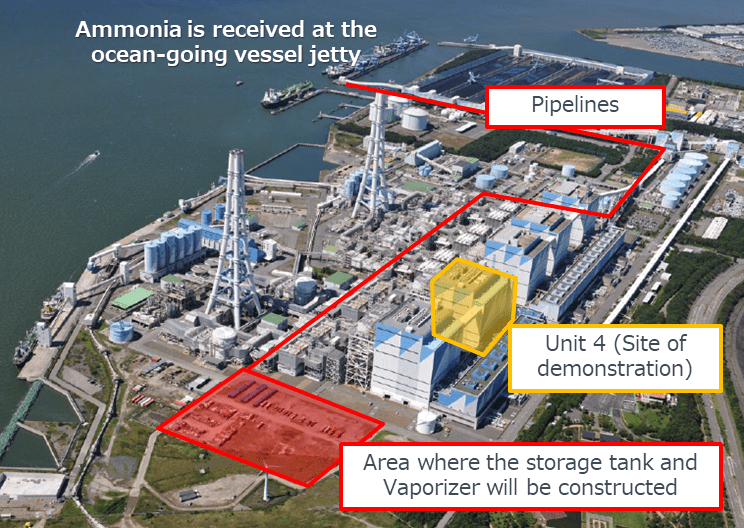Project Will Burn Ammonia with Coal to Cut Emissions
Japan’s largest power generation company plans to begin using ammonia as a fuel at one of its coal-fired plants as part of an effort to reduce the facility’s emissions of carbon dioxide (CO2).
JERA Co., a joint venture between Tokyo Electric Power Co. Holdings (TEPCO) and Chubu Electric Power, and IHI Corp., a Japanese engineering company, on May 24 said the four-year test project will begin in June and run to March 2025. The companies said it will be the world’s first major project to develop technology to enable co-firing a significant amount of ammonia at a large-scale commercial coal-fired plant.
The demonstration is aimed toward an eventual ammonia co-firing rate of 20% at the 1-GW Unit 4 of JERA’s 4.1-GW Hekinan Thermal Power Station, beginning in fiscal year 2024. The project is designed to establish ammonia co-firing technology by co-burning coal and ammonia. It will evaluate both boiler heat absorption, and the co-firing’s environmental impact characteristics such as exhaust gases. JERA has said it would like to use 100% ammonia as a fuel in the 2040 decade as part of the company’s own carbon-neutral target.
Viable Alternative Fuel
Ammonia does not emit CO2 when burned, and it is considered a viable alternative fuel in thermal power generation. The project is part of Japan’s move to hit the country’s target of net-zero CO2 emissions by 2050.
The companies in a news release Monday said, “Under its ‘JERA Zero CO2 Emissions 2050′ objective, JERA has been working to reduce CO2 emissions from its domestic and overseas businesses to zero by 2050, promoting the adoption of greener fuels and pursuing thermal power that does not emit CO2 during power generation. JERA will continue to contribute to energy industry decarbonization through its own proactive efforts to develop decarbonization technologies while ensuring economic rationality.”
The companies said JERA will carry out a smaller experiment with ammonia between August and December of this year, using burners at the 1-GW Unit 5 of the Hekinan plant, which is located in the central Japan prefecture of Aichi. JERA and IHI plan to burn about 200 metric tons (mt) of ammonia during those tests at Unit 5, according to JERA.

Japan’s use of thermal power generation became more important after the country took its nuclear power plants offline after the 2011 Fukushima Daiichi incident. Most of those plants remain shuttered. The country’s government now wants to reduce its dependence on fossil fuels and increase its use of renewable energy.
JERA officials on Monday said their company will be in charge of ammonia procurement and construction of related facilities such as the storage tank and vaporizer at the plant. IHI’s role is to develop the burners that will be used in the demonstration.
The announcement comes just three days after representatives of the G7 nations, including officials from Japan and the U.S., vowed to stop financing for overseas coal projects by the end of this year.

JERA on Monday did not disclose the cost of the ammonia project, although a spokesperson said the Japanese government would finance at least half of the demonstration. Government data, though, shows that the power generation cost at a coal-fired station with 20% ammonia is estimated at 12.9 yen ($0.12) per kilowatt hour (kWh), 20% above the 10.4 yen ($0.10) per kWh without ammonia.
Global Supply Chain
Japanese officials have said they want to create a global supply chain of ammonia for use as fuel; the government has said it wants to increase the nation’s annual ammonia fuel demand to three million mt by 2030, up from zero now. Ammonia currently is used in fertilizer and other industrial materials. Researchers have said it could be an important energy source, along with hydrogen, and said it should be valued because it does not emit CO2 when burned.
JERA officials on Monday said the company expects to procure 30,000 to 40,000 mt of ammonia by fiscal year 2024-25, which runs from April 2024 to March 2025, to enable the 20% co-firing at Hekinan’s Unit 4. A February-released policy report from Japan’s Ministry of Economy, Trade and Industry, said the country plans to have 3 million mt of ammonia available annually by 2030. A ministry official earlier this year said a 1-GW coal-fired power plant would need about 500,000 mt/year of ammonia for 20% co-burning.
—Darrell Proctor is associate editor for POWER (@POWERmagazine).